The GGFI (Global Green Finance Index) - An Overview
By
Simon Mills
Published by The FinReg Blog (18 August 2021).
This blog post, published on Duke University School of Law's influential FinReg Blog, introduces readers to the Global Green Finance Index (GGFI) and gives a helicopter view of the lessons learned and trends uncovered over the last seven editions of the GGFI.
Background
Just a few years ago, green finance was dismissed as a fringe activity. However, the rise of new financial instruments – such as Green Bonds and Fintech applications which reduce risk and open up new markets – has firmly moved green finance into the mainstream. When combined with public concern on climate change and policy makers’ preoccupation with low-carbon economic growth, it is unsurprising that financial centres around the world are looking to expand their share of this emerging sector.
But what is the true scope and scale of green finance? Which financial centres are real leaders and innovators, and which are merely paying lip service? How can the growth of the sector be encouraged? And what does effective policy and regulation look like?
In an attempt to answer these questions, Long Finance established a partnership with Brussels-based NGO Finance Watch and the Swiss-based MAVA foundation to deliver the Global Green Finance Index (GGFI). The GGFI ranks the world’s financial centres on their performance in delivering green finance. The aim is to focus on best practices and foster a race to the top among financial centres. We hope that as a result, policymakers’ understanding of the drivers of green growth will be improved, and financial systems can be shaped to support sustainability goals.
The GGFI is a factor assessment index that is collated by combining questionnaire assessments from financial services professionals, regulators, and policymakers with quantitative factors to produce rankings. For the seventh edition of the GGFI, research was conducted into 124 centres using 4,536 financial centre assessments provided by 739 questionnaire respondents. This was combined with quantitative data from 140 sources to construct the index.Details of our methodology can be accessed here.
Analysis
The GGFI contains a wealth of data and analysis which covers all aspects of the growth and development of the green finance sector over the last four years. However, several broad conclusions can be drawn from the last seven editions of the GGFI:
- Green finance is on a roll—as ESG analytics, reporting, and other aspects of green finance penetrate mainstream financial activity, there is growing confidence in the development of green finance across all regions. As a result, leading centres in this field cannot rest on their laurels—European centres were pioneers in developing green products and services, but other regions are rapidly catching up, and may well surpass them in the next few years.
Figure 1 Average Ranking Of Regional Centres Over Time
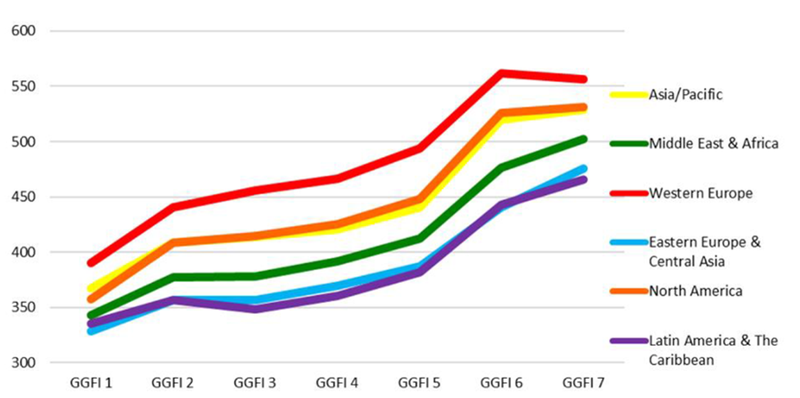
- Success in other aspects of financial services is no guarantee of success in green finance. The Global Financial Centres Index, the longer-established sister index of the GGFI, has been measuring financial centre competitiveness since 2007. Comparing the top 10 centres in the GFCI with the GGFI reveals significant variance.
Figure 2 Comparison of the top 10 GFCI Centres with their placement in the GGFI
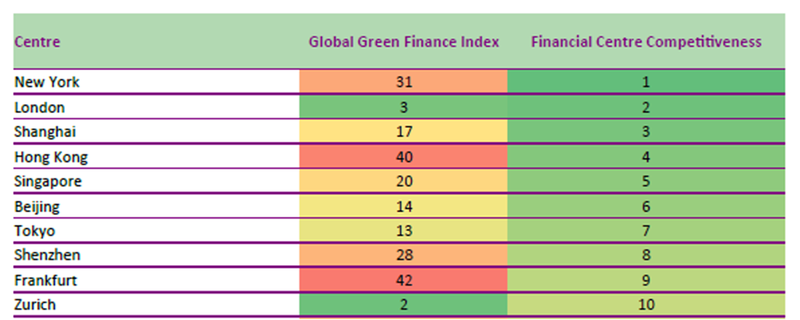
- Getting the fundamentals right is a prerequisite for success in green finance. The instrumental factors (quantitative data) used in the GGFI model are grouped into four broad categories: Sustainability, Infrastructure, Human Capital, and Business (see figure 3).
Figure 3 Instrumental Factors
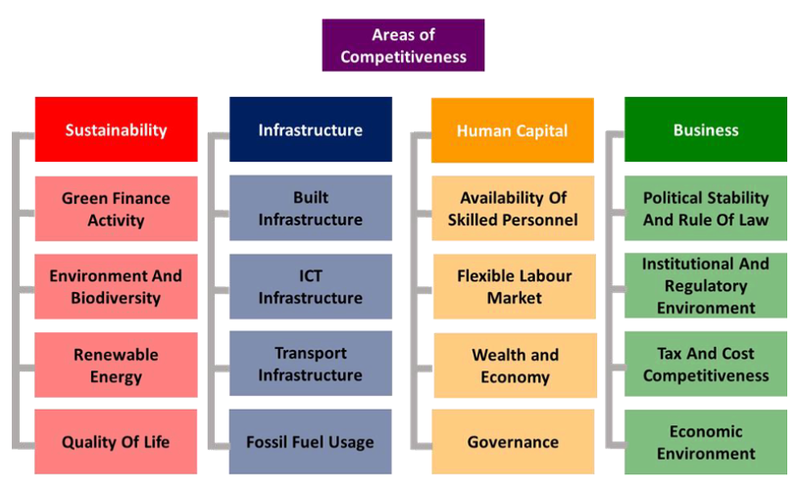
To assess how financial centres’ green finance offerings perform against each of these areas, the GGFI statistical model is run for each area of competitiveness separately, allowing a picture to be built of centres’ strengths and weaknesses. Figure 4 illustrates how the ranking of the top 10 centres changes depending on the focus.
Figure 4 Top 10 Centres By Area Of Competitiveness
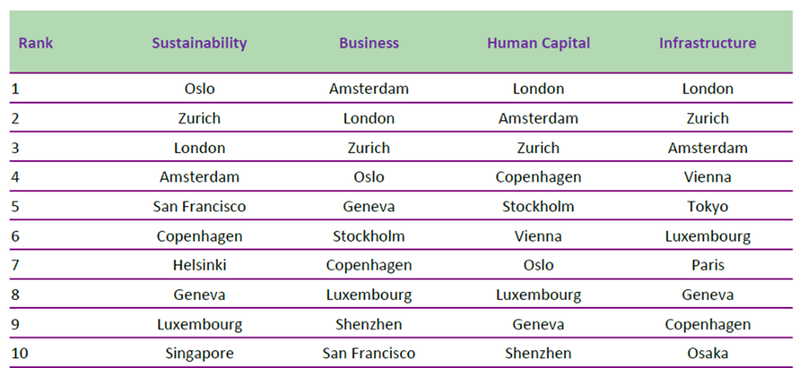
Practitioners’ Views
In addition to gathering finance professionals’ views on the depth and quality of work in financial centres, the GGFI questionnaire asks additional questions concerning the development of green finance—in particular on regulation, taxation, and the availability of skills.
- With respect to the regulatory environment, the European Union and UK Financial Conduct Authority requirements on sustainability reporting (including Non-Financial Disclosure Requirements) were cited as key drivers of growth in green finance.
- Many respondents identified significant gaps in training provision and expertise as critical factors reducing the capacity of the green finance sector to maximise growth.
- No consensus exists on the issue of taxation, with many respondents indicating that they considered taxation irrelevant or of very low importance.
- Political risk was identified as a significant drag on the growth of green finance
Further information is gathered on issues affecting the development path of green finance. For example, we research the areas of green finance thought to have the biggest impact on sustainability.
Figure 5 The Most Impactful Areas Of Green Finance

We also look into the factors driving the development of green finance.
Figure 6 The Drivers Of Green Finance
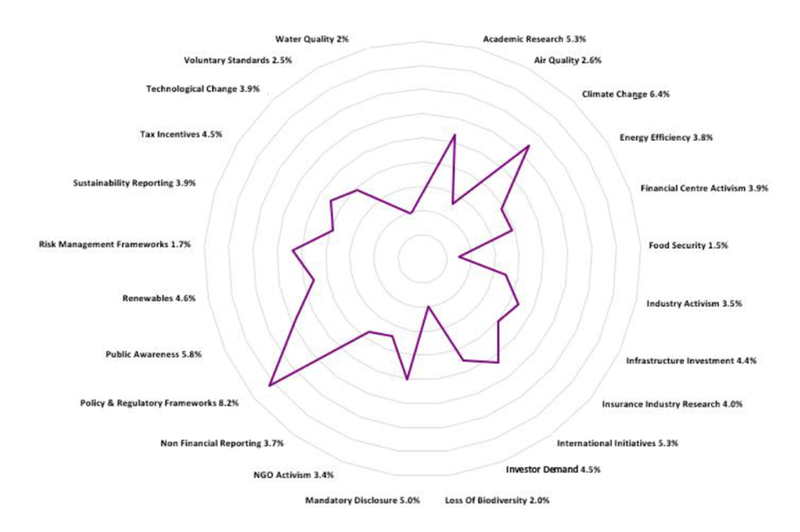
Conclusions
Every six months, the Global Green Finance Index (GGFI) evaluates the performance of financial centres around the world. The quantity of data that has been collected for the index continues to grow. As the reputation of the GGFI as a measure of financial centre green finance performance develops, centres are contacting Long Finance to request deep dives on the data, comparing their performance with those of their immediate peers. In this way, they hope to shape their policies and strategies to gain a competitive advantage.
Simon Mills is a Principal Consultant at the Z/Yen Group
Every edition of the GGFI is available to download in full, free of charge here. You can also find details of other Long Finance research, including the world’s largest free to access collection of ESG reports (The London Accord) on our website.
If you would like to share your views on the green finance performance of the financial centres you are familiar with, please complete our questionnaire. GGFI 8 will be published in October.